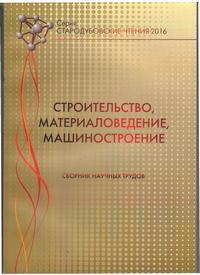On the formation of secondary border centrifugal cast steel 40х25н20с2
Keywords:
centrifugal casting, cracks, grain structure, polygonizational structure, secondary boundariesAbstract
Purpose. Study of the formation of secondary grain boundaries during crystallization in centrifugally-cast billets (steel grade 40Х25Н20С2). Methodology. The microstructure of hollow billets (steel grade 40Х25Н20С2) produced by horizontal centrifugal casting machines was analyzed. Features of secondary grain boundaries in 40Х25Н20С2 steel were examined in the caststate after annealing at temperatures of 1100°C and 1200°C and equalizing for one and five hours. Metallographic (Neophot-21) and electron microscopic (JSM-35, Tesla, EMW-100B) studies were conducted. Findings. It was found that changes in technological parameters of centrifugal casting leading to a reduction of the transcrystallization area and increased surface areas of equiaxed crystals in the structure of centrifugal-cast hollow billets (steel grade 40Х25Н20С2) allow reducing susceptibility to brittle intercrystalline fracture. Hot cracks of crystallization origin and polygonizational cracks form in castings. It is shown that formation of crystallization cracks is significantly affected by chemical heterogeneity, while formation of polygonizational cracks is affected by substructural heterogeneity caused by formation of secondary boundaries. A significant means to reduce susceptibility of cast steel to generation of microfraction is to control the scale and nature of chemical and substructural heterogeneity. Originality. We discuss the main sources of polygonizational formation of secondary grain boundaries in centrifugally-cast steel. Practical value. The obtained results allow using the secondary boundaries to inhibit the development of intergranular cracks.
References
Yudin S. B., Levin M. M., Rozenfeld S. E. Tsentrobezhnoe lite [Spun casting]. - M.: Mashinostroenie, 1972. – 415 s. (inRussion).
Movchan B.A. Granitsyi kristallitov v lityih metallah i splavah [The boundaries of the crystallites in cast metals and alloys]. K., Tehnika, 1970, 212s. (inRussion).
Gubenko S.I., Parusov V.V., Derevyanchenko I.V. Nemetallicheskie vklyucheniya v stali [Non-metallic inclusions in steel]. Dnepropetrovsk: ART-PRESS, 2005, 536s. (inRussion).
Gubenko S.I. Transformatsiya nemetallicheskih vklyucheniy v stali[Transformation of non-metallic inclusions in steel]. – M.: Metallurgiya, 1991. – 225 s. (inRussion).
Idelchik I.E. Gidravlicheskoe soprotivlenie [Pressure drop]. - L.: GosEnergoizda, 1954. – 221s. (inRussion).
Sarotovkin D.D. Dendritnaya kristallizatsiya[dendritic crystallization]. - M. : Metallurgizdat,1953. – 176s. (inRussion).
Golikov I.N., Maslenkov S.B. Dendritnaya likvatsiya v stalyah i splavah[Dendritic segregation in steels and alloys]. - M.: Metallurgiya, 1977. – 224 s. (inRussion).
Grabskiy M.V. Struktura granits zeren v metallah [The structure of grain boundaries in metals]. M., Metallurgiya, 1972, 160s. (inRussion).
Bokshteyn B.S., Kopetskiy I.V., Shvindlerman L.S. Termodinamika i kinetika granits zeren v metallah [Thermodynamics and Kinetics of grain boundaries in metals]. - M.: Metallurgiya, 1986. – 224 s. (inRussion).
Kosevich V.M., Ievlev V.M., Palatnik L.S., Fedorenko A.I. Struktura mezhkristallitnyih i mezhfaznyih granits [The structure of intergranular and interphase boundaries]M.: - Metallurgiya, 1980. – 256 s. (inRussion).
Bokshteyn B.S., Kopetskiy I.V., Shvindlerman L.S. i dr. Struktura i svoystva vnutrennih poverhnostey razdela v metallah [The structure and properties of the internal interfaces of metals]- M.: Nauka, 1988. – 272 s. (inRussion).
Finkel V.M. Fizika razrusheniya [Destruction Physics]. - M.: Metallurgiya, 1970. – 376 s. (inRussion).
Kaybyishev O.A., Valiev R.Z. Granitsyi zeren i svoystva metallov [Grain boundaries and properties of metals]. - M.: Metallurgiya, 1987. – 214 s. (inRussion). Статья рекомендована к публикации д-ром.техн.наук, проф. В. И. Большаковым (Украина); д-ром.физ.-мат.наук, проф. Д. В. Лаухин (Украина)
Downloads
Published
Issue
Section
License
Редакція Видання категорично засуджує прояви плагіату в статтях та вживає всіх можливих заходів для його недопущення. Плагіат розглядається як форма порушення авторських прав і наукової етики.
При виявлені у статті більш ніж 25% запозиченого тексту без відповідних посилань та використання лапок, стаття кваліфікується як така, що містить плагіат. У цьому випадку стаття більше не розглядається редакцією, а автор отримує перше попередження.
Автори, в статтях яких повторно виявлено плагіат, не зможуть публікуватися в усіх журналах Видавництва ДВНЗ «Придніпровська державна академія будівництва та архітектури».
Автори, які публікуються у цьому журналі, погоджуються з наступними умовами:
- Автори залишають за собою право на авторство своєї роботи та передають журналу право першої публікації цієї роботи на умовах ліцензії Creative Commons Attribution License, котра дозволяє іншим особам вільно розповсюджувати опубліковану роботу з обов'язковим посиланням на авторів оригінальної роботи та першу публікацію роботи у цьому журналі.
- Автори мають право укладати самостійні додаткові угоди щодо неексклюзивного розповсюдження роботи у тому вигляді, в якому вона була опублікована цим журналом (наприклад, розміщувати роботу в електронному сховищі установи або публікувати у складі монографії), за умови збереження посилання на першу публікацію роботи у цьому журналі.
- Політика журналу дозволяє і заохочує розміщення авторами в мережі Інтернет (наприклад, у сховищах установ або на особистих веб-сайтах) рукопису роботи, як до подання цього рукопису до редакції, так і під час його редакційного опрацювання, оскільки це сприяє виникненню продуктивної наукової дискусії та позитивно позначається на оперативності та динаміці цитування опублікованої роботи (див. The Effect of Open Access).

